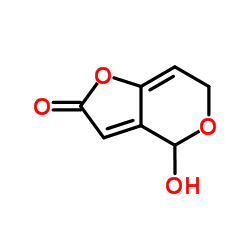Glucose oxidase

Glucose oxidase structure
|
Common Name | Glucose oxidase | ||
|---|---|---|---|---|
| CAS Number | 9001-37-0 | Molecular Weight | 154.120 | |
| Density | 1.5±0.1 g/cm3 | Boiling Point | 513.7±50.0 °C at 760 mmHg | |
| Molecular Formula | C6H12O6 | Melting Point | N/A | |
| MSDS | Chinese USA | Flash Point | 226.8±23.6 °C | |
| Symbol |

GHS08 |
Signal Word | Danger | |
Use of Glucose oxidaseGlucose oxidase is used in the food and beverage industry as a preservative and stabilizer and is commonly derived from the fungus Aspergillus niger. Glucose oxidase can react with intracellular glucose and oxygen (O2) to produce hydrogen peroxide (H2O2) and gluconic acid, which can cut off the nutrition source of cancer cells and consequently inhibit their proliferation[1][2][3]. |
| Name | Oxidase glucose |
|---|---|
| Synonym | More Synonyms |
| Description | Glucose oxidase is used in the food and beverage industry as a preservative and stabilizer and is commonly derived from the fungus Aspergillus niger. Glucose oxidase can react with intracellular glucose and oxygen (O2) to produce hydrogen peroxide (H2O2) and gluconic acid, which can cut off the nutrition source of cancer cells and consequently inhibit their proliferation[1][2][3]. |
|---|---|
| Related Catalog | |
| Target |
Microbial Metabolite |
| In Vitro | Glucose oxidase is a subset of oxidoreductase enzymes that catalyzes the transfer of electrons from an oxidant to a reductant. Glucose oxidases use oxygen as an external electron acceptor that releases hydrogen peroxide (H2 O2). Glucose oxidase has many applications in commercial processes, including improving the color and taste, increasing the persistence of food materials, removing the glucose from the dried egg, and eliminating the oxygen from different juices and beverages[4]. |
| References |
| Density | 1.5±0.1 g/cm3 |
|---|---|
| Boiling Point | 513.7±50.0 °C at 760 mmHg |
| Molecular Formula | C6H12O6 |
| Molecular Weight | 154.120 |
| Flash Point | 226.8±23.6 °C |
| Exact Mass | 154.026611 |
| LogP | -0.75 |
| Appearance of Characters | solution (clear) | yellow |
| Vapour Pressure | 0.0±3.0 mmHg at 25°C |
| Index of Refraction | 1.603 |
| Storage condition | 2-8°C |
| Symbol |

GHS08 |
|---|---|
| Signal Word | Danger |
| Hazard Statements | H334 |
| Precautionary Statements | P261-P342 + P311 |
| Personal Protective Equipment | dust mask type N95 (US);Eyeshields;Faceshields;Gloves |
| Hazard Codes | Xn,Xi |
| Risk Phrases | 42-36/37/38 |
| Safety Phrases | 45-22-23-36-26-24/25 |
| RIDADR | NONH for all modes of transport |
| WGK Germany | 1 |
| RTECS | RQ8452000 |
| HS Code | 35079090 |
|
RESOLFT nanoscopy with photoswitchable organic fluorophores.
Sci. Rep. 5 , 17804, (2015) Far-field optical nanoscopy has been widely used to image small objects with sub-diffraction-limit spatial resolution. Particularly, reversible saturable optical fluorescence transition (RESOLFT) nano... |
|
|
Compartmentalization of the chick cerebellar cortex based on the link between the striped expression pattern of aldolase C and the topographic olivocerebellar projection.
J. Comp. Neurol. 523 , 1886-912, (2015) The avian cerebellum is organized into multiple longitudinal stripes defined by expression profiles of aldolase C (zebrin II) in Purkinje cells. The relationship between the aldolase C striped pattern... |
|
|
Spatial Control of Epsin-induced Clathrin Assembly by Membrane Curvature.
J. Biol. Chem. 290 , 14267-76, (2015) Epsins belong to the family of highly conserved clathrin-associated sorting proteins that are indispensable for clathrin-mediated endocytosis, but their precise functions remain unclear. We have devel... |
| beta-D-Glucose:quinone oxidoreductase |
| (2,4-Dihydroxy-2H-pyran-3(6H)-ylidene)acetic Acid 3,4-Lactone |
| Alfamalt Gloxyl 4080 |
| 4H-Furo(3,2-c)pyran-2(6H)-one, 4-hydroxy- |
| DL-Patulin |
| Mycoin C3 |
| beta-D-Glucose oxidase |
| Clavacin |
| Claviformin |
| EINECS 232-601-0 |
| Penicidin |
| Clairformin |
| Patulin |
| Bakezyme G01500 |
| gigantin |
| MFCD00131182 |
| Clavatin |
| Patuline |
| Claviform |
| 4-Hydroxy-4H-furo[3,2-c]pyran-2(6H)-one |
| 4H-Furo[3,2-c]pyran-2(6H)-one, 4-hydroxy- |

